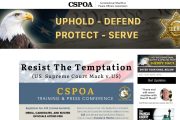
According to a Gallup poll published on October 13, 2010, 59 percent of Americans think the federal government has too much power. This represents a dramatic, 20-percent increase over the past seven years. Furthermore, we’ve all witnessed an amazing series of federal power grabs in the past few years: the bailouts, the government takeovers, the stimulus bill, the healthcare “reform” law known as ObamaCare, the financial regulatory law, the EPA’s regulation of greenhouse gases, the trillion-dollar deficits. Among constitutionalists, libertarians, Tea Party activists, Republicans, and Independents, the common expression is that our federal government is “out of control.”
The Tenth Amendment Movement
In 2008, Oklahoma state Representative Charles Key put into motion a new movement to rein in the federal government based on the Tenth Amendment, which holds that besides those few and defined powers expressly delegated by the Constitution to the federal government, all other powers are “reserved to the States respectively, or to the people.” Rep. Key’s Resolution 1089 powerfully asserts:
THAT the State of Oklahoma hereby claims sovereignty under the Tenth Amendment to the Constitution of the United States over all powers not otherwise enumerated and granted to the federal government by the Constitution of the United States.
THAT this serve as Notice and Demand to the federal government, as our agent, to cease and desist, effective immediately, mandates that are beyond the scope of these constitutionally delegated powers.
Economics professor Walter E. Williams provided a major publicity assist to Rep. Key’s effort with his nationally syndicated column on July 16, 2008, entitled “Oklahoma Rebellion.” Dr. Williams concluded his article by saying: “State efforts, such as Oklahoma’s, create a glimmer of hope that one day Americans and their elected representatives will realize that the federal government is the creation of the states.”
Over the next two years this “glimmer of hope” became a reality, as the Tenth Amendment movement spread rapidly throughout the nation. Already by the end of 2009, 38 states had introduced Tenth Amendment resolutions based on the Oklahoma model. By 2010, 21 states had passed a Tenth Amendment resolution in one or both houses, and five Governors had gone on to sign their state’s resolution.
This unprecedented assertion of state sovereignty over those powers not delegated to the federal government by the Constitution reflects a widespread awakening of millions of Americans, and large numbers of state legislators, regarding the importance of reining in the federal government by insisting on adherence to the Constitution.
The Founders of our Republic did not intend that state nullification would be the ordinary means of reining in federal usurpations; the constitutional system they provided us relies primarily on the prudence and vigilance of the citizens to place responsible men and women in Congress who will pass laws agreeable to the Constitution, and who will keep the executive and judicial branches from overreaching their bounds. The November 2010 congressional elections demonstrated that informed, responsible voters can indeed still “throw the bums out” who disregard the Constitution. However, it is very unlikely that the electoral changes were sufficient to effect the size of roll-back needed to cut the federal government back to its proper size and halt its unconstitutional interference in state, local, and personal matters. State nullification is a fail-safe feature inherent in the very makeup of our system of government as agreed to by the original 13 states.
Shall We Enforce the Constitution ?or Revise the Constitution?
The movement to restore the Constitution, however, has encountered a fork in the road. One path builds on the Tenth Amendment movement by introducing and passing measures in state legislatures to nullify various unconstitutional federal laws, such as federal firearms laws and ObamaCare. Let’s call this choice, “States Enforce the Constitution.” The adherents of the second path seek to convince constitutionalists that what’s needed to rein in the federal government is a constitutional convention (Con-Con) as provided for by Article V of the Constitution to propose some new amendments to the Constitution. Let’s call this choice, “States Revise the Constitution.”
To choose the correct choice, we must understand the problem — namely that all three branches of the federal government routinely disregard major portions of the Constitution, despite the fact that the original 13 states created a compact, or agreement, designating as their agent, a federal government composed of executive, legislative, and judicial branches with their powers enumerated in the Constitution.
Thus, the states must re-assert themselves soon as the parties to the original compact that established the federal government as their agent and enforce the Constitution, or face eventual extinction at the hands of the federal government. As James Madison wrote regarding the states, “There can be no tribunal above [the states’] authority, to decide in the last resort, whether the compact made by them be violated.”
The enforcement-through-state-nullification route builds on the ideas of the Founders and posits that the states, which created the federal government in the first place, can begin re-asserting themselves immediately by virtue of their superior status as the creators of the federal government and by using those powers never delegated to the federal government. In contrast, revising the Constitution through an Article V convention would not immediately reassert the dominance of the states over the federal government; hence, the federal government would be permitted to continue to operate according to its self-assigned role as ultimate arbiter of violations of the constitutional compact. This in turn would delay the necessary reassertion by the states of their superior status over the federal government while everyone is kept waiting for a possible realignment of state-federal power to emerge from an Article V constitutional amendment process. Meanwhile, the federal government would continue to increase its control over the states and their citizens — taking our freedoms, rights, and money.
The Constitution and ?State Nullification
None other than Thomas Jefferson provided the rationale for the states to rein in an errant federal government by enforcing the Constitution through nullification. In 1798, both Jefferson and James Madison were greatly alarmed and personally threatened by the unconstitutional Alien and Sedition Acts that had been passed by the Federalists. It is very significant that they didn’t recommend the convening of a new constitutional convention as provided for by Article V of the Constitution.
Not only did Jefferson completely ignore an Article V constitutional convention as a remedy for what he considered an out-of-control federal government, he went on to provide us with both the conceptual framework and specific word for reining in such an out-of-control federal government — nullification. He did this with his Kentucky Resolutions of 1798 and 1799:
If those who administer the general government be permitted to transgress the limits fixed by that compact, by a total disregard to the special delegations of power therein contained, an annihilation of the state governments, and the creation, upon their ruins, of a general consolidated government, will be the inevitable consequence.
Jefferson wisely warned that allowing the central government to be the sole judge of the extent of its own powers would result in “nothing short of despotism.” He held further that “the several states who formed that instrument, being sovereign and independent, have the unquestionable right to judge of its infraction; and, That a nullification, by those sovereignties, of all unauthorized acts done under color of that instrument, is the rightful remedy.” (Emphasis added.)
Two hundred eleven years later, Jefferson’s “rightful remedy” for unconstitutional actions by the federal government is very much alive. Earlier this year, historian Thomas Woods published his new book, Nullification: How to Resist Federal Tyranny in the 21st Century, which provides an overview of the many applications of the nullification concept in our nation’s history. A leading current example is the national movement among state legislatures to nullify the Individual Mandate of the ObamaCare law. Since the “Freedom of Choice in Health Care” model legislation was introduced in December 2008, it has been filed or pre-filed in 38 states. It has been enacted into law in six states (Arizona, Georgia, Idaho, Louisiana, Missouri, and Virginia), passed but vetoed by the Governor in Florida and Oklahoma, and placed on the November 2, 2010 ballot as a constitutional amendment in Arizona, Colorado, and Oklahoma. On November 2, Oklahoma voters passed a constitutional amendment to nullify the Individual Mandate of ObamaCare by 65 percent to 35 percent, Arizona passed its amendment by a vote of 55 percent to 45 percent, and Colorado narrowly rejected its amendment by a vote of 47 percent to 53 percent.
Although this partial nullification of the unconstitutional ObamaCare law is a good first step, two leading supporters of the Tenth Amendment movement, The John Birch Society and the Tenth Amendment Center, have introduced model legislation for state nullification of the entire ObamaCare law. Since the Individual Mandate is such a tiny portion of the ObamaCare law, and since the unconstitutional remainder of the law would be more than enough to complete a government takeover of our nation’s healthcare system even without the Individual Mandate, the entire ObamaCare law should be nullified.
Revision Risks Great Under Con-Con
In contrast to the state nullification path, attempting to rein in the federal government by revising the Constitution through a new constitutional convention convened according to Article V is inherently very, very risky.
The major risks are:
• Once called, a Constitutional Convention becomes its own authority and cannot be limited;
• A corollary to the point above is that a Con-Con may become a “runaway convention” that drastically alters our form of government, or throws out the Constitution altogether and establishes an entirely new system of governance.
• It is absurd to believe that a majority (or even a sizable minority) of the individuals likely to be delegates to a Con-Con today would compare favorably with our nation’s Founders or share their commitment to liberty and limited government.
• The general public’s understanding of our Constitution has deteriorated greatly, while dependence on government programs has dramatically escalated since our founding, with both of these factors militating for bigger and bigger government.
Nevertheless, a number of organizations are lobbying furiously for a Con-Con, so we will spend most of the rest of this article detailing why convening one is inherently dangerous, focusing on the four points mentioned above. Con-Con advocates appeal to various constituencies with proposed amendments to require a balanced federal budget, term limits for Congress, a presidential line-item veto, as well as a number of other proposals. Article V of our Constitution, they point out, provides for calling a Con-Con upon “the Application of the Legislatures of two thirds of the several States.” Which means that once 34 states apply for a Con-Con, Congress must initiate a convention.
Con-Con proponents argue that worries over whether the convention may exceed its mandate are unfounded, since the state legislatures can limit the Con-Con to consideration of a single issue, such as a Balanced Budget Amendment. However, against these unsupported assurances, we respond with the learned opinions of jurists and constitutional experts from the Founding era to the present, as well as with the unanswerable argument of experience.
James Madison himself, father of the Constitution, warned against convening a second constitutional convention. When he learned that New York and Virginia were actively calling for an Article V convention in 1788, just months since ratification of the Constitution, he was horrified. He counseled:
If a General Convention were to take place for the avowed and sole purpose of revising the Constitution, it would naturally consider itself as having a greater latitude than the Congress…. It would consequently give greater agitation to the public mind; an election into it would be courted by the most violent partisans on both sides … [and] would no doubt contain individuals of insidious views, who, under the mask of seeking alterations popular in some parts … might have the dangerous opportunity of sapping the very foundations of the fabric…. Having witnessed the difficulties and dangers experienced by the first Convention, which assembled under every propitious circumstance, I should tremble for the result of a second, meeting in the present temper in America. [From a letter by James Madison to G.L. Turberville, November 2, 1788.]
There in a nutshell you have the basic warning by The John Birch Society, the Eagle Forum, the American Policy Center, and many other constitutionalist organizations, against the convening of an Article V constitutional convention.
Madison clearly did not believe that a Con-Con could be limited and trembled at the thought of one. Madison’s view that it is impractical, or even impossible, to limit a Con-Con is shared by a wide array of jurists and legal scholars, including noted Democrats and Republicans, liberals, conservatives, and libertarians. Among those who have addressed this issue are former Chief Justice of the United States Supreme Court Warren E. Burger, former U.S. Supreme Court Justice Arthur J. Goldberg, Prof. Lawrence H. Tribe of Harvard Law School, Prof. Charles E. Rice of Notre Dame Law School, Prof. Thomas I. Emerson of Yale Law School, and Prof. Gerald Gunther of Stanford University Law School.
No Protection ?Against Convention
Another scholar who has weighed in on this issue is Judge Robert Bork, who served as Solicitor General, acting Attorney General, and judge for the United States Court of Appeals for the District of Columbia Circuit. In a letter to State Representative Reese Hunter of Utah on January 16, 1990, Judge Bork stated:
Specifically, you asked for my opinion on the question: “Can a constitutional convention be limited by Congress or the states to a single issue?”… It is my view … that a federal constitutional convention could not be limited to a single issue…. The original Philadelphia convention went well beyond the purposes for which it was called and nobody has suggested the Constitution is a nullity for that reason.
Accordingly, I do not see how a convention could be limited to one topic once it had been called.
As Judge Bork noted, our original Constitutional Convention of 1787, which would be a powerful precedent for any new constitutional convention, was a “runaway” convention in the sense that the delegates exceeded both their instructions from the Confederate Congress and the original agreement between the 13 states, the Articles of Confederation. The Confederate Congress convened the convention for “the sole and express purpose of revising the Articles of Confederation.” Nevertheless, the Constitutional Convention immediately set about devising an entirely new plan of government that would replace wholly the Articles of Confederation and establish a completely new national legislature in place of the then-existing Confederate Congress. Then, even though Article XIII of the Articles of Confederation required that all alterations in the Articles be approved by the unanimous consent of the state legislatures of all of the states, the Constitutional Convention created its own provisions for ratification in Article VII of the new Constitution: 1) only nine states would be required to ratify this new Constitution instead of 13; and 2) ratification of the new Constitution would be accomplished through state conventions, not state legislatures.
That is the only Con-Con we have experienced. We are extremely fortunate that it resulted in the “Miracle in Philadelphia” and not the “Debacle in Philadelphia.” The citizens of our nation have been blessed with great personal freedom and prosperity for the past 221 years since the Constitution of 1787 went into effect. However, the above evidence shows just how independent and even high-handed such a runaway convention can be. Even though pro Con-Con advocates often take great pains to assure us that a new Article V convention for proposing amendments would not lead to a runaway convention, the most prominent precedent, the Constitutional Convention of 1787, makes fears of a new runaway convention seem quite realistic.
State Ratification No Cure-all
Note at this point that, despite assurances of the pro Con-Con advocates that we would be protected from any “bad” or “crazy” amendments proposed by an Article V convention because all such amendments would have to be ratified by three-fourths (38) of the states before being added to the Constitution, a modern-day Con-Con could change the ratification process, as was the case with the Convention of 1787, or that under Article V Congress could choose whether amendments are ratified by state legislatures or state conventions. Our original Constitutional Convention in 1787 specified state conventions for ratification of their new creation. Since the time of the adoption of the new Constitution, Congress has chosen state legislatures as the mode of ratification for amendments — except in the case of the 21st Amendment, which repealed Prohibition. In that case, Congress, lacking confidence that it would be ratified by three-fourths of the state legislatures, opted for ratification by special state conventions instead.
While the additional requirement of ratification by three-fourths of the states does provide some protection from “bad” or “crazy” amendments, we all know just how many tens of millions, and perhaps hundreds of millions, of dollars can be mobilized by special interest groups to influence Americans in elections. If some “individuals of insidious views” could succeed in getting damaging amendments proposed in an Article V constitutional convention, then it’s probable that many political and special-interest organizations with deep pockets, as well as the biased mainstream media, would get involved in a huge way to promote the ratification of any amendments that would further their agenda.
Will Madisons and Washingtons ?Run a New Con-Con?
Historians and political observers from throughout the world have marveled at the constitutional creation that emerged from the Philadelphia convention of 1787. The caliber and character of the men involved in that great endeavor, all agree, were remarkable: George Washington, James Madison, Benjamin Franklin, Robert Morris, George Mason, Edmund Randolph, Rufus King, Roger Sherman, John Rutledge, et al.
Are we likely to see a similar constellation of statesmen should a new Con-Con be called? Or would we be more likely to be convening an experiment that would end up placing our Constitution, our liberty, and the future of our children’s children in the hands of politicians of the ilk of Nancy Pelosi, Newt Gingrich, Harry Reid, John McCain, and Barney Frank?
As noted above, not only must we contend with the fact that most of the politicians in power at the state and federal levels do not share the constitutionalist views of the Founders, but most of our fellow citizens are woefully uneducated regarding the Constitution. Very few have actually read it and fewer still have read The Federalist Papers, which were written by Madison, Hamilton, and Jay as popular essays to explain the Constitution to the American people of their day.
Pro Con-Con Organizations Are Lobbying State Legislators
Space does not permit the listing of all the organizations and individuals that are contacting state legislators this winter with the goal of influencing at least 34 state legislatures to introduce and pass a resolution during the 2011 session petitioning Congress to call an Article V constitutional convention to propose one or more amendments. However, here’s a statement from just one of the pro Con-Con organizations that shows how organized and committed they are to getting their model Con-Con call resolution passed by 34 states in 2011:
In January of 2011 history will be made when the same Article V Convention Resolution is introduced in every state legislature in the United States. Never before has the same call for an Amendments Convention occurred at the same time. The 10 Amendments for Freedom organization is well on its way to having a sponsor in every state which will introduce the same resolution.
— 10 Amendments for Freedom, www.10amendments.org, August 4, 2010
Thirty Years of Con-Con Battles
This battle over whether to convene an Article V constitutional convention is not new. Back in 1983 Missouri became the 32nd state to petition Congress to convene a constitutional convention for the purpose of proposing a Balanced Budget Amendment (BBA).
Since one of the major selling points for the pro Con-Con advocates is that state legislatures can restrict a constitutional convention as to which amendments or what subject matter can be considered, a separate count is maintained for the number of states that make a Con-Con call for each type of amendment(s). By this accounting only two more states would have been needed to force Congress to convene a Con-Con to consider proposing a Balanced Budget Amendment.
About this time members of The John Birch Society (JBS) and their allies got involved in persuading state legislators in the remaining 18 states against issuing any more BBA Con-Con calls. Not only was the BBA Con-Con movement stopped dead in its tracks, but JBS members went on the offense and worked with state legislators to introduce and pass resolutions to rescind all previous Con-Con calls. Beginning with Alabama and Florida in 1988, a total of 17 state legislatures (Ala., Ariz., Ga., Idaho, Fla., La., Mont., N.D., N.H., Okla., Ore., S.C., S.D., Tenn., Va., Utah, and Wy.) have become so thoroughly convinced of the dangers of a constitutional convention that they have voted to rescind (take back) all previous Con-Con calls in their states. This total was reduced by one this year when Florida issued a new BBA Con-Con call. So the total of states that have rescinded their calls now stands at 16. See the maps at the end of this article for the 32 states that have issued BBA Con-Con calls (Figure 1) and the 16 states that have rescinded all of their previous Con-Con calls (Figure 2).
Persuade State Legislators to Enforce, Not Revise, the Constitution
If you would like to help in a grassroots action project in your state to rein in the federal government by (1) persuading state legislators to enforce the Constitution through nullification of the entire ObamaCare law and other unconstitutional federal laws, (2) stopping the new drive to revise the Constitution by defeating all Con-Con call resolutions, and (3) preserving the Constitution by persuading state legislators to introduce and pass Con-Con rescission resolutions in those 34 states that haven’t done so, then go to http://www.jbs.org/issues-pages/Stop-Obamacare and http://www.jbs.org/issues-pages/No-Con-Con. These are the web pages for two of The John Birch Society’s highest priority action projects: “Choose Freedom — STOP ObamaCare” and “Choose Freedom — STOP A Con-Con.”
Given the two-year cycle of state legislatures whereby state legislators are elected in the general elections held in early November of even-numbered years and open their legislative sessions very soon after January 1, the critical time for contacting state legislators regarding nullification of ObamaCare, blocking calls for a Con-Con, and rescinding all previous calls for a Con-Con is this present month of December 2010 and the first few months of 2011. In many states a vote on a Con-Con call could occur as early as the first week or two of January. Time is of the essence.
Preserve Our Freedom
If we are to preserve our freedom under the Constitution, then the states must rein in our out-of-control federal government by enforcing the Constitution through nullification of unconstitutional federal laws, rather than by revising the Constitution through an inherently risky constitutional convention process!
[Click here to download a PDF of this article as it appeared in print in the December 6, 2010 issue of The New American magazine; the PDF includes a “Key Quotes” sidebar that has not been included in this online article.]





